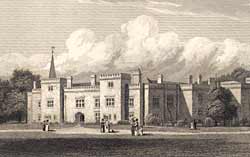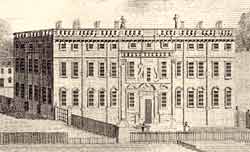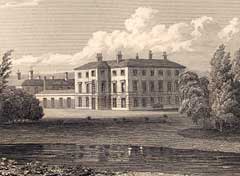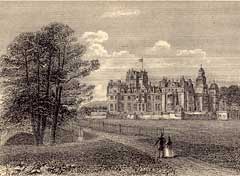Manvers Collection: Family Seats
The ancient seat of the de Manvers family, and afterwards the Pierrepont family, Holme Pierrepont Hall has a medieval core but has been substantially remodelled. The present south front was built by Sir William Pierrepont (d 1534) in the early years of the sixteenth century. The arch, flanked by towers, was the first domestic building in brick in Nottinghamshire. The 1st Earl of Kingston-upon-Hull built ranges on the north side of the courtyard in the early seventeenth century, which were pulled down by the 2nd Duke of Kingston-upon-Hull in the late 1730s.

Holme Pierrepont Hall, Nottinghamshire, c.1812
After the death of the Marquess of Dorchester in 1680, the Pierrepont family were based at Thoresby and used Holme Pierrepont as a second residence, a dower house, or a house for elder sons prior to their inheritance. From 1773 to 1788 the Hall was part of the dower of Elizabeth Chudleigh, Duchess of Kingston. The 1st Earl Manvers made some alterations to the house in the first decade of the nineteenth century.
It was requisitioned by the government during both the First and Second World Wars and left empty during the intervening period. The Hall was lived in and renovated by Lady Sibell Argles (daughter of the 4th Earl Manvers) until her death in 1968. It was then purchased by Elizabeth Brackenbury (a descendent of the 3rd Earl Manvers) and her husband Robin, and is still owned and occupied by their family.
Although a house had existed at Thoresby before the end of the 16th century, the first house used by the Pierreponts was begun by William, 4th Earl of Kingston-upon-Hull, in 1683. He had bought land in Perlethorpe and the hays of Bilhagh in Sherwood Forest from the Crown to form Thoresby Park. It was designed by William Talman, subsequently architect of Chatsworth.

The first Thoresby Hall, Nottinghamshire, engraved by J. Walker
This first house was burnt down in April 1745, with, according to The Gentleman's Magazine, nothing saved 'but the writings, plate, and a little of the best furniture'. The Hall was completely rebuilt by the architect John Carr (1723-1807), and completed in 1772. It was refurbished by Charles Pierrepont (later 1st Earl Manvers) after he succeeded to the estate in 1788, and the park was landscaped by Humphrey Repton.

The second Thoresby Hall, Nottinghamshire, c.1812
In 1864 the second house was demolished on the orders of the 3rd Earl Manvers. Its low situation next to the lake had often been criticised as unhealthy, and the new Hall, designed by Anthony Salvin in a Victorian Gothic style, was built slightly uphill and in a more imposing position.

The third Thoresby Hall, Nottinghamshire
In 1980 Thoresby Hall was sold to the National Coal Board, which was contemplating opening a seam of coal underneath it. Lady Manvers, widow of the 6th Earl, lived there until her death in 1984. In 1987 British Coal announced the sale of the Hall to a hotel management company. Furniture, artworks, artefacts and printed books from the Hall were sold by Sotheby's on 31 May, 1 June and 2 June 1989. Thoresby Hall is now a hotel owned by the Warner Group.
The core of the Pierrepont properties was the Holme Pierrepont estate in south Nottinghamshire, which came into the family in the late thirteenth century. Sir George Pierrepont (d 1564) purchased a number of former monastic estates in Nottinghamshire following the dissolution of the monasteries in the 1530s. Sir Robert Pierrepont (1584-1643) was created Earl of Kingston-upon-Hull in 1628, and purchased extensive estates in North Nottinghamshire (Thoresby, Laxton etc.), Derbyshire (Beighton, Calow, Oldcotes and Heath), Lincolnshire (Newball, Hagworthingham, Crowle, Hemingby, Langton-by-Wragby) and Yorkshire (Adwick upon Dearne, Wothersome, and Ingleby Arncliffe). The Orton Longueville estate in Huntingdonshire came to him through his marriage.
Following Robert's death in 1643, his eldest son Henry, created Marquess of Dorchester in 1645, succeeded to the Holme Pierrepont and Orton Longueville estates. However, most of the Earl's purchased estates were settled on his second son William Pierrepont (d 1679) of Tong Castle (Shropshire) and later of Thoresby. William's eldest son, Robert Pierrepont, inherited the Thoresby and Lincolnshire estates, and also acquired the West Dean (Wiltshire and Hampshire) estate through his wife Elizabeth, daughter and heir of Sir John Evelyn. The Derbyshire, Yorkshire and Shropshire properties were again left to younger sons. The Marquess of Dorchester died without male issue in 1680, when he was succeeded as 3rd Earl of Kingston by his great-nephew Robert Pierrepont of Thoresby. From then on, Thoresby became the main residence, in preference to Holme Pierrepont Hall.
The 5th Earl of Kingston sold Orton Longueville in 1706, but inherited the Beighton and Adwick estates on the death of Samuel Pierrepont of Oldcotes in 1707. He also acquired the Shropshire and other Yorkshire estates, together with an estate at Hanslope (Buckinghamshire), on the death of his uncle, Baron Pierrepont of Hanslape, in 1715. Estates in Yorkshire (except Adwick) were sold during the eighteenth century, as were Hanslope in 1763, Tong in 1764 and West Dean after 1773.
As rent receipts for agricultural land fell in the late nineteenth and early twentieth centuries, the family began selling some of their estates. Large-scale sales of properties began in 1874 with the sale of the Bath estate. Properties in Wiltshire, Lincolnshire, Derbyshire and Yorkshire were sold in the 1910s and 1920s, and some of the outlying Nottinghamshire estates in the 1930s. Death duties following the death of the 5th Earl in 1940 forced the sale of the Holme Pierrepont estate, comprising 23 farms, and 5465 acres of land. By 1950 the estate was limited to properties in Perlethorpe, Budby, Edwinstowe, Laxton, Kneesall, Kersall and Eakring, plus chief rents from Weston, and rents from canal, railway and utility companies on the old Holme Pierrepont estate. Thoresby Hall was sold in 1980 although an estate still survives, based at Thoresby Park.
The main Pierrepont properties in each county were as follows. References in brackets are to the main Manvers collections which include relevant title deeds and documents, although material is scattered throughout and researchers are encouraged to use keyword searches:
Buckinghamshire
- Hanslope. Inherited by the 1st Duke of Kingston-upon-Hull in 1715. Sold 1763
- Beaconsfield.
Cambridgeshire/Norfolk
-
Underwoods Farm, Whittlesey, Cambridgeshire, and Vines Farm, Wiggenhall, Norfolk. Purchased by the 6th Earl Manvers in 1952-3 and sold in 1956 (see Ma 3)
- Inkerson Grange Farm, Parsons Drove, Cambridgeshire. Purchased by the 6th Earl Manvers in 1955 and sold in 1986 (see Ma 9 and Ma 10)
Derbyshire
- Beighton. Acquired by the 1st Earl of Kingston-upon-Hull, early 17th century. Sales on the estate started in 1895, with the bulk of the properties sold in 1912-13. The remaining portion was sold in 1946 (see Ma 3001-5876, Ma 2 and Ma 3)
- Heath and Calow. Acquired by the 1st Earl of Kingston-upon-Hull, early 17th century. Most sold in 1911 (see Ma 3001-5876)
- Owlcotes. Acquired by the 1st Earl of Kingston-upon-Hull, early 17th century
Huntingdonshire
- Orton Longueville. Brought to the 1st Earl of Kingston-upon-Hull through his marriage, 1602. Sold 1706
Lincolnshire
- Bassingthorpe cum Westby. Acquired by the 1st Earl of Kingston-upon-Hull, early 17th century. Sold 1802
- Crowle. Acquired by the 1st Earl of Kingston-upon-Hull, early 17th century (see Ma 3001-5876 for manor court records 1692-1859; Ma A-X for court rolls 1567-1766, admission fine books and accounts 1756-1901, and manorial survey 1629; Ma 2 for title deeds etc., 1813-1943, and for manorial fines on admission, 1828-1949)
- Hagworthingham. Acquired by the 1st Earl of Kingston-upon-Hull, early 17th century. Sold 1911 (see Ma 3001-5876)
- Hemingby. Acquired by the 1st Earl of Kingston-upon-Hull, early 17th century. Sold 1911 (see Ma 3001-5876)
- Langton-by-Wragby. Acquired by the 1st Earl of Kingston-upon-Hull, early 17th century. Sold 1911 (see Ma 3001-5876)
- Langworth. Acquired by the 1st Earl of Kingston-upon-Hull, early 17th century. Sold 1911 (see Ma 3001-5876)
- Newball. Acquired by the 1st Earl of Kingston-upon-Hull, early 17th century. Sold 1911 (see Ma 3001-5876)
Middlesex
- Ground rents in Elthorne Avenue, Hanworth. Purchased 1903, sold 1964 (see Ma 3)
Nottinghamshire
- Holme Pierrepont estate. Core estate made up of land at Holme Pierrepont, Adbolton, Gamston, Bassingfield, Cotgrave, Clipston, Radcliffe-on-Trent, Lamcote and surrounding areas. Acquired through marriage of Henry de Pierrepont to Annora de Manvers, daughter of Michael de Manvers, and sister and heiress of Lionel de Manvers, in late 13th century. Further land in Cotgrave bought by Sir George Pierrepont (d 1564). Radcliffe-on-Trent property was sold in 1914 and 1920. Bulk of estate sold 1941. (see Ma 3001-5876 and Ma 3 for title deeds; Ma M for Holme Pierrepont manor court papers; and Ma 11 for correspondence and estate papers)
- Gedling, Carlton and Stoke Bardolph. Owned by 1684 (see Ma 3001-5876 for title deeds)
- Nottingham, Colwick and Sneinton. Piecemeal sales up to 1933 (see Ma 3001-5876 and Ma 3 for title deeds)
- Edwinstowe manor. Acquired 1828 from the Duke of Portland, in exchange for the manor of Holbeck and Woodhouse and lands in Cuckney, Norton, Hatfield Grange, Holbeck, Holbeck Woodhouse, Holbeck Woodhouse Hall, Warsop and Kirkby in Ashfield (see Ma 2, Ma 3, Ma 5, Ma 9 and Ma 10 for deeds and estate papers)
- Holbeck. Owned by Sir Robert Pierrepont in the early 14th century. Manor of Holbeck and Woodhouse and lands in Cuckney, Norton, Hatfield Grange, Holbeck, Holbeck Woodhouse, Holbeck Woodhouse Hall, Warsop and Kirkby in Ashfield, bought by Sir George Pierrepont (d 1564). Given to Duke of Portland in 1828 in exchange for manor of Edwinstowe
- Laxton. Acquired by the 1st Earl of Kingston-upon-Hull, early 17th century. Manor sold 1951 (see Ma 3001-5876 for deeds, Ma B for estate papers, Ma 3 for surveys and estate papers, Ma 4 for 1812 map, Ma 5 for accounts and manorial papers, and Ma 9 and Ma 10 for estate papers)
- Kneesall, Dunham, Eakring, Weston and Fledborough. Owned by 1684. Further purchases 1866-71. Sold 1917, 1930-31 and 1941. (see Ma 3001-5876 and Ma A-X for Eakring and Weston manor court records 1653-1718; Ma 2 for Kersall and Kneesall deeds; Ma 3 for title deeds; Ma 5, Ma 9 and Ma 10 for estate papers)
- Thoresby, Perlethorpe, Budby, Ollerton etc. Acquired by the 1st Earl of Kingston-upon-Hull in 1633. Most properties sold during 20th century. Thoresby Hall sold 1980. (see Ma 3, Ma 9 and Ma 10 for estate papers)
- Walkeringham. Sold 1911 (see Ma 3001-5876 for title deeds and estate papers)
- Widmerpool. (see Ma 3001-5876 for manor court records 1680-1718)
Shropshire
- Tong Castle. Acquired through marriage of William Pierrepont (d 1679). Sold 1764
Somerset
- Bath. Acquired through marriage of son of 1st Duke of Kingston-upon-Hull with Rachel Bayntun, heiress of the Hall family, in 1711. Sold 1874. (see Ma 3001-5876 for register of leases 1735-53; and Ma 2 for papers relating to the sale)
Wiltshire
- Bradford-on-Avon, Great and Little Trowle, Trowbridge, Paxcroft and Holt. Sold 1913-14. (see Ma 3001-5876 and Ma 2 for title deeds)
- West Dean. Acquired through marriage of Robert Pierrepont of Thoresby, late 17th century. Sold after 1773
Yorkshire
- Adwick upon Dearne. Acquired by the 1st Earl of Kingston-upon-Hull, early 17th century. Sold early 20th century
- Ingleby Arncliffe. Acquired by the 1st Earl of Kingston-upon-Hull, early 17th century. Sold 18th century
- Wothersome. Acquired by the 1st Earl of Kingston-upon-Hull, early 17th century. Sold 18th century
Next page: Manvers Family biographies